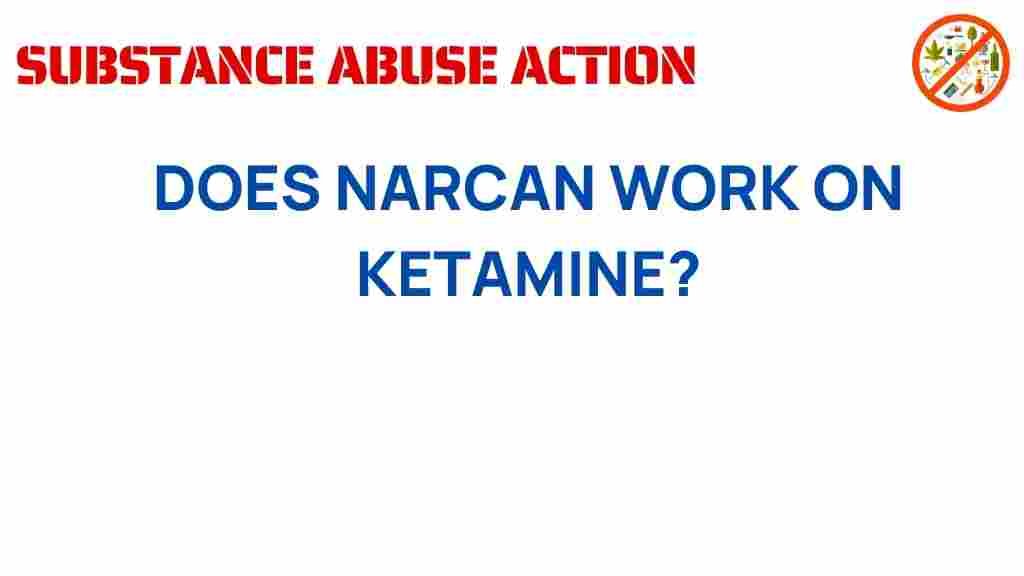The Surprising Truth: Does Narcan Work on Ketamine Overdoses?
In recent years, the opioid crisis has drawn significant attention to emergency response measures aimed at saving lives during overdose situations. One of the most notable developments in this arena is the widespread availability of Narcan (naloxone), a medication that reverses opioid overdoses. However, as we grapple with various substances, a critical question arises: Does Narcan work on ketamine overdoses? This article explores the intricacies of Narcan, ketamine, and overdose scenarios while addressing safety, harm reduction, and the importance of informed healthcare responses.
Understanding Narcan and Ketamine
Narcan is a brand name for naloxone, an opioid antagonist that blocks the effects of opioids in the body. It is primarily used in emergency response situations to counteract the life-threatening effects of an opioid overdose, such as respiratory depression and unconsciousness. On the other hand, ketamine is a dissociative anesthetic often used for anesthesia in medical settings but is increasingly misused recreationally. Although it has some opioid-like effects, it operates through different mechanisms in the brain.
What Happens During a Ketamine Overdose?
A ketamine overdose can lead to a range of symptoms, including:
- Severe dissociation
- Respiratory depression
- High blood pressure
- Increased heart rate
- Unconsciousness
- Potential for seizures
While ketamine overdoses can be serious, they do not typically lead to the same type of respiratory collapse seen in opioid overdoses. This distinction is crucial when considering the effectiveness of Narcan in these situations.
How Narcan Works: The Mechanism of Action
Narcan works by binding to the same receptors in the brain that opioids bind to, effectively displacing them and reversing their effects. This action can restore normal breathing and consciousness in individuals experiencing an opioid overdose. However, it is important to note that Narcan is specifically designed for opioid receptors and does not have the same efficacy for other substances like ketamine.
The Limitations of Narcan in Ketamine Overdoses
Research indicates that Narcan does not work on ketamine overdoses due to the following reasons:
- Different Mechanisms: Ketamine primarily interacts with NMDA receptors and other neurotransmitter systems, while Narcan targets opioid receptors.
- Respiratory Function: Ketamine overdoses may not lead to respiratory depression in the same way opioids do, diminishing the need for opioid antagonists.
- Emergency Response Protocols: Emergency responders need to be trained to recognize the signs of ketamine overdose versus opioid overdose, as the treatment approaches differ.
In essence, while Narcan is a vital tool in the fight against opioid overdoses, it is not effective for reversing the effects of ketamine, underscoring the importance of proper identification and treatment of overdose scenarios.
Emergency Response to a Ketamine Overdose
In cases of a suspected ketamine overdose, the response should focus on ensuring the safety and wellbeing of the individual. Here’s a step-by-step guide on how to respond:
Step 1: Assess the Situation
Determine if the person is responsive. Check for:
- Awareness of surroundings
- Ability to talk or follow commands
- Breathing patterns
Step 2: Call for Help
If the individual appears unresponsive or is having difficulty breathing, call emergency services immediately. Provide clear information about the situation and the suspected substance involved.
Step 3: Provide Basic Life Support
If trained, administer basic life support techniques, including:
- Checking for a pulse
- Administering rescue breaths if necessary
- Positioning the person safely on their side to prevent aspiration
Step 4: Monitor Until Help Arrives
Stay with the individual and monitor their condition. Be prepared to provide information to emergency responders about the quantity of ketamine taken and the time of ingestion.
Safety and Harm Reduction Strategies
Given the potential for ketamine overdoses, it’s essential to prioritize safety and harm reduction strategies in both recreational and medical contexts. Here are some tips:
- Education: Awareness and education about the risks associated with ketamine use can help users make informed decisions.
- Testing Kits: Utilizing drug testing kits can help users identify the purity and composition of substances before consumption.
- Supervised Use: If using ketamine recreationally, consider doing so in supervised settings where help is readily available.
- Emergency Contacts: Always have emergency contact information on hand, including access to local healthcare services.
Recognizing Drug Interactions
It’s also crucial to understand potential drug interactions that could exacerbate the effects of ketamine. Combining ketamine with other substances, particularly depressants like alcohol or benzodiazepines, can heighten the risk of overdose. Users should be advised to:
- Consult healthcare professionals before mixing substances.
- Stay informed about the interactions between ketamine and other medications.
Conclusion: The Importance of Preparedness in Overdose Situations
In conclusion, while Narcan is a life-saving medication for opioid overdoses, it is not effective for reversing the effects of ketamine overdoses. Emergency response protocols must be tailored to the specific substance involved, emphasizing the need for education and awareness surrounding the use of ketamine. By understanding the unique characteristics of ketamine and implementing safety measures, we can better prepare individuals and healthcare providers to respond effectively to overdose situations.
For more information on overdose prevention and treatment strategies, visit SAMHSA. To learn more about Narcan and its applications, check out our detailed resource here.
Remember, the best approach to dealing with drug use and potential overdoses is through education, preparedness, and harm reduction strategies. Stay safe and informed!
This article is in the category Treatment and created by SubstanceAbuseAction Team
